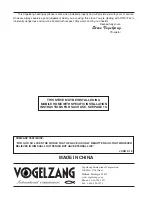
Page 16 / TR007 PONDEROSA™
Vogelzang International Corp.
VGZ-031 / 20120619.1
height, weather, log size, wood species and moisture
content. Some experimentation will initially be required
to find that “sweet spot” where your stove performs best.
The following will give you a starting point to find your
optimum settings.
When first loading fuel set the primary air inlet con-
trol (center) at the wide open (push in) position for at
least 15–20 minutes (the high burn duct control should
be closed – pulled out – when starting fires). When the
stove is working properly you should be able to observe
secondary combustion flames above the fuel pieces in
front of the secondary air tubes at the top of the firebox.
These secondary flames should continue to burn after
the primary air inlet is reset from wide open to the de-
sired operating setting. If the flames do not continue to
burn, open the air control to re-establish the secondary
flames then slowly reset the air control to the desired
setting. Initially it may take several attempts to figure
your stove out. But once you find the operating “sweet
spot” and the correct mix of procedures to get there,
only minor adjustments will be necessary.
The best indicator of a properly operating stove is
to look for smoke coming out of the chimney. You may
see steam emissions that will quickly dissipate. Smoke
will thin but continue to drift without totally disappearing.
If you do detect smoke emissions, open the air control
a little bit, let the stove adjust for 10–15 minutes and
re-check your chimney. Remember – visible smoke
represents lost heat.
NOTICE - INITIAL BURNS TO CURE PAINT
BECAUSE OF THE HIGH OPERATING
TEMPERATURES, THIS STOVE USES
A SPECIAL HIGH-TEMP PAINT WHICH
REQUIRES A SERIES OF BURNS TO
CURE THE PAINT FOR DURABILITY AND
A LIFETIME OF SERVICE.
P r o p e r c u r i n g o f t h e h i g h - t e m p p a i n t
requires a series of three initial burns. The stove
should be allowed to cool off between each burn.
The first two burns should be small fires and low
temperatures (250°F/120°C) for a duration of
20 minutes each. The third fire should be at a
medium-high temperature (500 to 700°F/260 to 370°C)
for twenty minutes. Provide adequate cross ventilation
to clear any smoke or odor caused by initial firings.
STARTING A FIRE
1. Set
Primary Air Inlet Control Lever “A” (control
located under the center of the hearth plate) to
fully open position (push control in towards back
of stove).
NOTE:
OPEN/HIGH=IN; CLOSED/LOW=OUT.
2. Set the
High Burn Control Lever “B” in illustration
below, (right control under the hearth plate) to the
fully closed position (pull center control fully out).
NOTE:
OPEN/HIGH=IN; CLOSED/LOW=OUT.
3. Open the feed door and place several wads of
crushed paper in the firebox.
4. Cover the paper with a generous amount of kindling
in a teepee fashion and a few small pieces of wood.
5. Ignite the paper and leave the door open slightly.
DO NOT LEAVE STOVE UNATTENDED WITH
DOOR OPEN! Except while tending the fire,
operating the stove with the feed door open or
ash clean out cover removed may cause over
firing resulting in unsafe operating conditions.
6. Add large pieces of wood as the fire progresses
being careful not to overload. (Do not fill firebox
beyond firebrick area.) An ideal coal bed of 1˝ – 2˝
(25mm - 50mm) should be established to achieve
optimum performance.
7. This unit is designed to function most effectively
when air is allowed to circulate to all areas of the
firebox. TIP: If ash or coals remain in the stove,
OPERATING INSTRUCTIONS continued . . .
continued on next page











































